By Gabrielle Cascio
What do you get when you put 8,500 international educators and community stakeholders in a room? A week of reflection, learning, and community building at NAFSA 2023! As a first-time attendee, I was equal parts overwhelmed and inspired by the breadth and depth of opportunities to think deeply about the work we do and its impact on fostering mutual understanding worldwide. As Secretary of State Blinken summarized so perfectly in his opening remarks: “International students share their talents and cultures with their new communities – and bring what they learned abroad back home. Exchanges can create lifelong friendships, spark artistic creativity, and fuel collaboration on groundbreaking research.” Blinken reaffirmed the Department of State’s commitment to streamlining and prioritizing US study visas and creating inclusive and accessible study abroad opportunities, a welcome message as international education faces unprecedented threats throughout the country.
As we celebrated our successes throughout the week, we were also pushed to think critically about what the future of international education looks like. NAFSA’s updated issue brief on a national strategy for international education speaks to the need for the United States to “increase its efforts to attract and retain the world’s best and brightest and ensure domestic students have access to opportunities that keep them competitive and equipped to collaborate across borders” in order to advance American foreign policy, diplomacy, innovation, national security, economic growth, and global competitiveness. Sessions led by SIOs, government officials, and other thought leaders proposed a variety of paths forward and reinforced just how important international education is to our shared future.
With so much to do and see over the course of five days, it is difficult for me to identify a single highlight or takeaway from #NAFSA75. That being said, as a young professional, I was heartened to see so many conversations with individuals in varying stages of their career about the importance of professional development, mentorship, and fostering the next generation of international education leaders. The creation of these safe spaces to discuss what it means to be an international educator and how everyone in the field is constantly learning and growing in their role is incredibly powerful.
Read on for more takeaways and key policy and regulatory updates shared during the week. For more insights from a NAFSA newcomer, I encourage you to check out Karin Fischer’s most recent Latitudes.
- Mark and Andrea joined Carl Herrin of Worcester State University and Rachel Banks of NAFSA for an engaging panel on current Hill dynamics and their impact on the exchange program budget and international student and study abroad policy changes.
- Mark attended NAFSA’s Hill Breakfast where Senator Dick Durbin pledged his commitment to passing the Paul Simon Study Abroad Program Act this Congress.
- The Department of Commerce announced that, for the first time, international education will be included as a priority in the forthcoming iteration of the U.S. national export strategy.
The Bureau of Consular Affairs is on track to issue 35% more international student visas this year than in 2019. This record-breaking statistic is the highest number of international student visas issued in nearly a decade. Deputy Assistant Secretary for Visa Services Julie Stufft also shared the Bureau’s goal of ensuring no student misses a program because of administrative processing.
